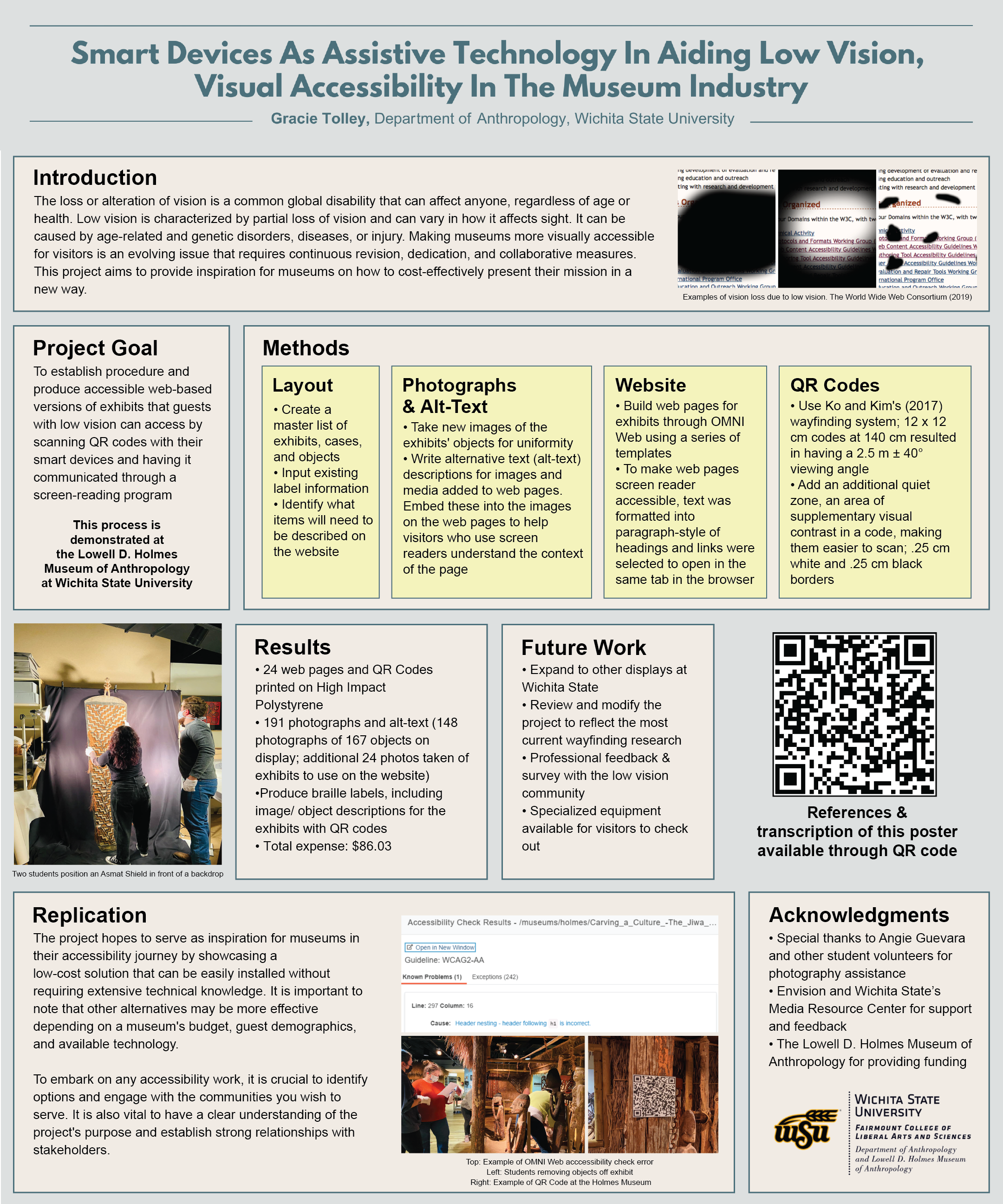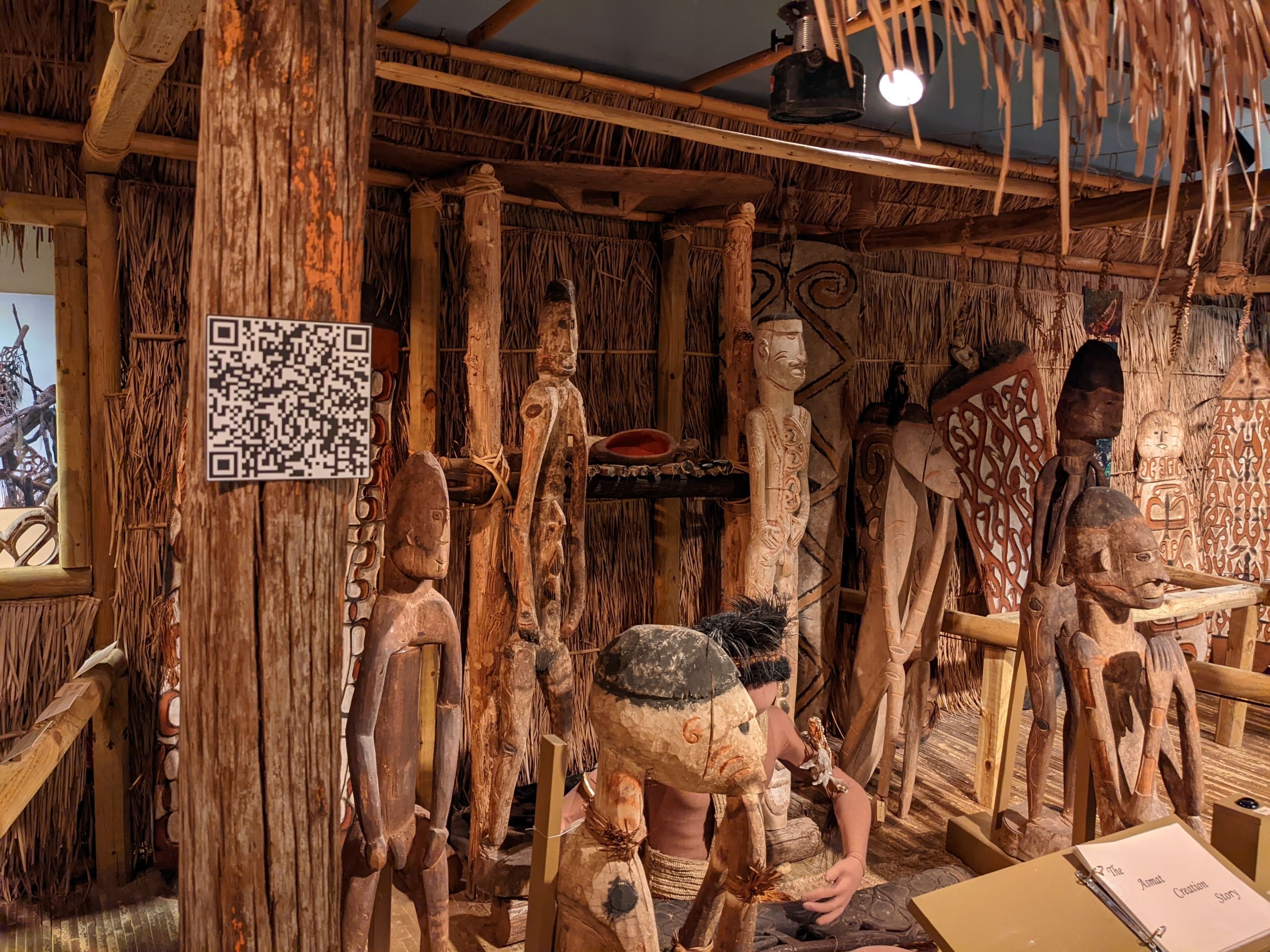Smart Devices as Assistive Technology in Aiding Low Vision, Visual Accessibility in the Museum Industry
A Graduate Project By Gracie Tolley
Master of Arts, Wichita State University, 2022
The loss or alteration of vision is one of the most common disabilities globally. Visual impairments are not often considered in traditional museum practices of exhibiting behind glass. To address this, The Lowell D. Holmes Museum of Anthropology in Wichita, Kansas, has transitioned to a quick response (QR) code-based accessibility solution. This solution links visitors to web pages containing information and descriptions of the museum's exhibits. Low vision guests use their smart devices' screen-reading programs to access this information. This project documents implementing this solution and discusses its benefits.
Procedure
A master list of exhibits, cases, and objects on display was produced to keep this procedure structured. This started by listing the exhibit, then breaking it down into individual cases and objects in them. This also helps create a system for displaying them on the website, as it will have a similar structure on the web pages. Additional items that would need to be described, such as photographs and charts, were also listed. Existing label information from exhibits were collected into this document under the objects.
For the web pages, high-quality pictures and images were required. New images of the exhibit's objects were taken for uniformity. Every image uploaded required alternative text (alt-text) descriptions. Short descriptions of images and other media on web pages are known as alt-text, and they help visitors who use screen readers understand the context of the image.
A museum must have a functional website with specific accessibility features for this solution to work. The Wichita State University website is built with OMNI web using a series of templates. When creating the web pages, certain steps were taken to make them accessible to users, including the titles being formatted into paragraph style of headings and links opening in the same tab in the internet browser.
QR codes were specifically sized and positioned to be easily scanned at the museum by a smart device. These were printed on high-impact polystyrene by a local print company. The advantage of QR codes is that they always direct users back to the URL. If something is changed on the webpage, the code can still be used.
Other Benefits from this Project
Even though it was not the project's initial purpose, this project helps expand the educational and outreach mission of a museum through digital accessibility. Not only can guests access exhibits in person, but guests can also access them at home. If the COVID-19 pandemic has shown the museum community anything, it would be that there needs to be a dedicated effort towards online education.
Museums may wish to shift their focus to more online education programming and museum access to reflect general education trends. This will allow museums to communicate their mission in a fresh way and expand their network.
The Holmes has introduced braille labels containing object descriptions for their online exhibits, and intends to extend this feature to the other exhibits overseen by the Holmes' curators at Wichita State in the near future. The project's initiatives may also prove helpful to guests with other disabilities. This is particularly significant for those who cannot physically visit the museum.
The Future of the Project
While a limited group of Wichita State students and staff have reviewed the labels and webpages for accessibility, the project seeks professional feedback on the solution. Additionally, the project aims to conduct a survey to gather opinions from museum guests regarding the initiative.
Conclusion
This was the best option for the Holmes when it came to addressing low vision, and the solution provided more benefits than was initially thought. This form of accessibility may not be appropriate for all museums. The museum industry is diverse, with institutions of varied sizes and subjects, so a different method may be more appropriate to meet their needs. The industry is changing, and museums need to become agents of change and take action toward equitable experiences. Museums should assess their space on a personal and professional level so that it can be a welcoming environment for all.
Abdinnour, Sue, Rachelle Meinecke, Lisa Parcell, and Jay M. Price. 2022. “Serving up a Slice of Entrepreneurship on Campus.” The Public Historian 44 (1): 51–77. https://doi.org/10.1525/tph.2022.44.1.51.
Anderson, Monica, and Andrew Perrin. 2017. “Tech Adoption Climbs Among Older Adults.” Pew Research Center. https://www.pewresearch.org/internet/wpcontent/uploads/s ites/9/201 7/05/PI_2017.05.17_Older-Americans-Tech_FINAL.pdf.
Art Beyond Sight. 2014. “Disability and Inclusion – Museum Access: Inclusive Practices in Museums.” http://www.artbeyondsight.org/dic/module-6-museum-access-inclusive-practices-by-museum-teams/museum-access-inclusive-practices-by-museum-teams/.
Crystal Bridges Museum of American Art. 2022. “Go Digital at Crystal Bridges.” Crystal Bridges Museum of American Art. https://crystalbridges.org/go-digital-at-crystal-bridges/.
Grand Valley State University. 2022. “Alt Text - Accessibility.” Grand Valley State University. https://www.gvsu.edu/accessibility/alt-text-7.htm.
Griffin-Shirley, Nora, Devender R. Banda, Paul M. Ajuwon, Jongpil Cheon, Jaehoon Lee, Hye Ran Park, and Sanpalei N. Lyngdoh. 2017. “A Survey on the Use of Mobile Applications for People Who Are Visually Impaired.” Journal of Visual Impairment & Blindness 111 (4): 307–23. https://doi.org/10.1177/0145482X1711100402.
Handa, Kozue, Hitoshi Dairoku, and Yoshiko Toriyama. 2010. “Investigation of Priority Needs in Terms of Museum Service Accessibility for Visually Impaired Visitors.” British Journal of Visual Impairment 28 (3): 221–34. https://doi.org/10.1177/026461
Hartford Courant. 2017. “NBMAA, CRIS Installs QR Codes To Enhance Museum Experience For Visually Impaired - Hartford Courant.” Hartford Courant. https://www.courant.com/ctnow/arts-theater/hc-art-audio-tours-cris-radio-nbmaa-20171125-story.html.
Industries for the Blind and Visually Impaired. 2021. “Blind vs. Visually Impaired: What’s the Difference?” Industries for the Blind and Visually Impaired. https://ibvi.org/blog/blind-vs-visually-impaired-whats-the-difference/.
Karrach, Ladislav, Elena Pivarčiová, and Pavol Božek. 2020. “Identification of QR Code Perspective Distortion Based on Edge Directions and Edge Projections Analysis.” Journal of Imaging 6 (7): 67. https://doi.org/10.3390/jimaging6070067.
Klein, Janice, and Chuck Dean. 2018. “Increasing Accessibility for Visitors Who Are Visually Impaired: Simple Solutions for Small Museums.” American Association for State and Local History (blog). https://aaslh.org/increasing-accessibility-for-visitors-who-are-visually-impaired-simple-solutions-for-small-museums/.
Ko, Eunjeong, and Eun Kim. 2017. “A Vision-Based Wayfinding System for Visually Impaired People Using Situation Awareness and Activity-Based Instructions.” Sensors 17 (8): 1882. https://doi.org/10.3390/s17081882.
National Federation of the Blind. 2016. “National Federation of the Blind and Blind Student Reach Agreement with Wichita State University.” National Federation of the Blind. https://nfb.org/about-us/press-room/national-federation-blind-and-blind-student-reach-agreement-wichita-state.
Perrin, Andrew. 2021. “Mobile Technology and Home Broadband 2021.” Pew Research Center. https://www.pewresearch.org/internet/wp-content/uploads/sites/9/2021/06/ PI_2021.06.03_Mobile-Broadband_FINAL.pdf.
Pressman, Heather, and Danielle Schulz. 2021. The Art of Access: A Practical Guide for Museum Accessibility. Rowman & Littlefield Publishers.
Solima, Ludovico, and Filomena Izzo. 2018. “QR Codes in Cultural Heritage Tourism: New Communications Technologies and Future Prospects in Naples and Warsaw.” Journal of Heritage Tourism 13 (2): 115–27. https://doi.org/10.1080/1743873X.2017.1337776.
The American Alliance of Museums. 1993. “AAM Code of Ethics for Museums.” American Alliance of Museums (blog). https://www.aam-us.org/programs/ethics-standards-and-professional-practices/code-of-ethics-for-museums/.
The Pennsylvania State University. 2014. “Image ALT Text.” Accessibility at Penn State. https://accessibility.psu.edu/images/alttext/.
The World Health Organization. 2012. “Global Data on Visual Impairments 2010.” Geneva: The World Health Organization.
———. 2021. “Vision Impairment and Blindness.” The World Health Organization. https://www.who.int/news-room/fact-sheets/detail/blindness-and-visual-impairment.
The World Wide Web Consortium. 2005. “Test Process.” The World Wide Web Consortium. https://www.w3.org/WAI/GL/WCAG20/tests/test3.html.
———. 2019. “Accessibility Requirements for People with Low Vision.” The World Wide Web Consortium. https://w3c.github.io/low-vision-a11y-tf/requirements.html.
Turbert, David, and Dan Gudgel. 2020. “Low Vision.” American Academy of Ophthalmology. https://www.aao.org/eye-health/diseases/low-vision.
U.S. Department of Justice Civil Rights Division, U.S. Small Business Administration, and Office of Entrepreneurial Development. 1999. “ADA Guide for Small Businesses.” U.S. Department of Justice.
Styles, David. 2021. “The Pandemic as an Opportunity to Reimagine Accessibility in Museums and Heritage.” Museums + Heritage Advisor. https://advisor.museumsandheritage.com/feat
ures/the-pandemic-as-an-opportunity-to-reimagine-accessibility-in-museums-and-heritage/. WebAIM. 2021a. “WebAIM: Alternative Text.” WebAIM. https://webaim.org/techniques/alttext/.
———. 2021b. “WebAIM: Screen Reader User Survey #9 Results.” WebAIM. https://webaim.org/projects/screenreadersurvey9/.
Wichita State University. 2022. “The MRC Guide to Accessible ALT Text.” https://www.wichita.edu/services/mrc/Web_Services/alttext_guide.php.
Wilkening Consulting, and The American Alliance of Museums. 2020. “Museum-Goers and Accessibility: A 2020 Annual Survey of Museum- Goers Data Story.
Project Poster



